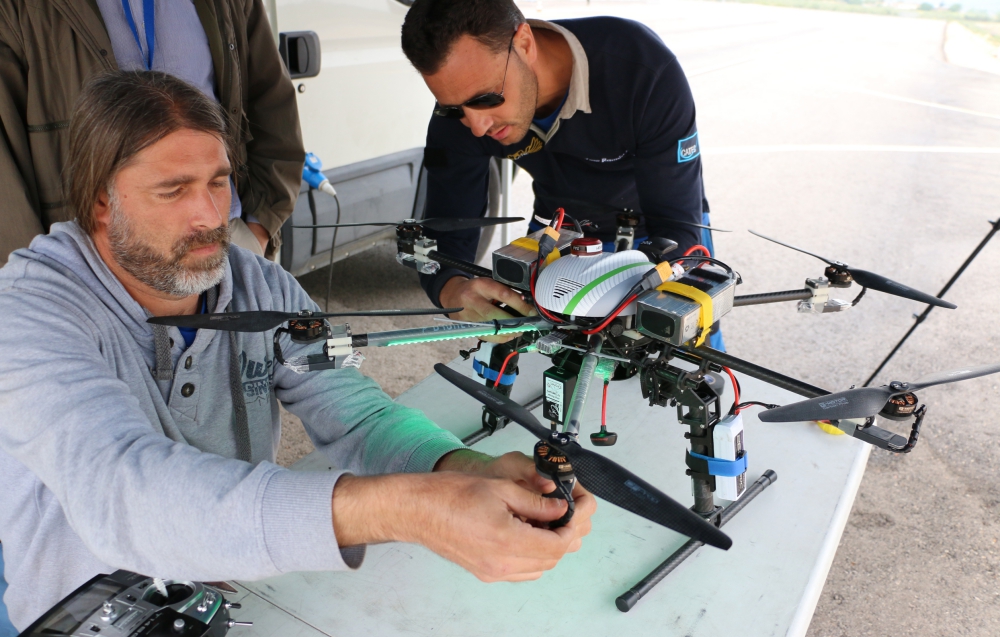The Center for Advanced Aerospace Technologies (CATEC) will host the II Local Tournament on the ERL Emergency Robots Challenge of the European Robotics League (ERL), to be held in February 2019. This event will bring together technology and research centers and international entities linked to the application and use of robots and unmanned systems (drones) in emergency situations.
The ERL Emergency Robots Challenge will serve to meet and experiment with the latest innovations and robotic applications that are being developed in the international scientific and technological field, and that seek to facilitate and improve the work that is usually performed in rescue operations, natural disasters, or fires, among other actions. All of this through the use of robots and avoiding the risk and danger that this type of actions entails for the people or professionals who take care of them. In the case of emergency situations, robotic systems play a key role by enabling rescue teams to sense and act at a distance from the emergency site.
CATEC will host the II Local Tournament of this international competition, which will focus on fostering advanced developments on autonomous capabilities and seamless outdoor/indoor navigation for air and land robots in applications related to emergency actions. Last July, first Local Tournament on the ERL Emergency Robots challenge was focused on land and sea robotic systems.
The tasks and functionalities that must be demonstrated and performed by the participating robots in the tournament hosted by CATEC should focus on aspects such as outdoor/indoor autonomous navigation, obstacle detection and avoidance, object recognition and locate missing persons, high speed flying or accurate delivery of items such as first aid kits.
During ERL Emergency 2019, there will be a special prize awarded by the European Global Navigation Satellite Systems Agency (GSA). A special task has been devised to assess positioning accuracy of robots that make use of solutions based on Galileo and EGNOS. This challenge includes two kind of tasks for aerial robots: Horizontal accuracy in landings at a specific geographic coordinate and Vertical accuracy while hovering at a specific geographic coordinate.
The European Robotics League (ERL) is the successor to the RoCKIn, euRathlon and EuRoC robotics competitions, and that looks for the development of diverse tasks and works that the participating robots must execute in outdoor/indoor real environments.
The ERL is made up of different local tournaments and other competitions that are held in different cities in Europe. Teams participate with their robots and innovative drones in at least two tournaments per year, obtaining scores based on their performances. The scores of the two best participations of each team in each tournament will be added to their results, so that they will be classified according to them. The prizes to the best European teams of all the competition will be granted during the European Robotics Forum (ERF) to be held in March 2019 in Bucharest (Romania).
Teams from universities and research and technology centers that want to participate in the II Local Tournament on the ERL Emergency Robots Challenge in Seville, Spain, must register from September 15 to October 10 here.
The ERL is a project funded by the EU Horizon 2020 programme.
SESAR Prize
During the European Robotics League (ERL) Emergency 2019, SESAR Joint Undertaking will award a prize recognising technological innovations to ensure the safe access to airspace for drones or aerial robots, in support of the European Commission’s U-space initiative
For this purpose, a special working group has been established in which selected teams can demonstrate that their technology has been devised to benchmark high levels of autonomy in aerial robots, in the context of U-space for the safe access to airspace for aerial robots. Specifically, functionalities related to detect and avoid will be assessed using only on-board sensors.
To achieve these objectives, aerial robots equipped with the competing technologies should complete a track test where there will be static obstacles and other non-cooperative robots present. Each aerial robot will be required to cross several waypoints without colliding against any obstacle and also detect and avoid non-cooperative drones, without the intervention of a human operator.
The more obstacles and non-cooperative drones the aerial robot detects and avoids, the more points the team will get. The team that achieves the best result will be the winner. To compete for the award, the team must have executed valid trials of the track. The prize will only be awarded if SESAR representatives consider that team’s performance is excellent.
Source: Press Release

